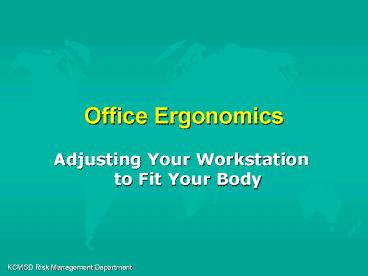Office Ergonomics - PowerPoint PPT Presentation
1 / 28
Title:
Office Ergonomics
Description:
OSHA defines ergonomics as the science of 'designing the ... Carpal Tunnel Syndrome. Epicondylitis. Tenosynovitis. Bursitis. KCMSD Risk Management Department ... – PowerPoint PPT presentation
Number of Views:580
Avg rating:3.0/5.0
Title: Office Ergonomics
1
Office Ergonomics
- Adjusting Your Workstation to Fit Your Body
2
What is Ergonomics?
- ERGO work
- NOMICS rules or laws
- Ergonomics literally means the laws of work
3
What is Ergonomics?
- OSHA defines ergonomics as the science of
designing the job to fit the worker, instead of
forcing the worker to fit the job.
4
What is Ergonomics?
- Ideally, ergonomics
- Makes the job safer by preventing injury and
illness - Makes the job easier by adjusting the job to the
worker - Makes the job more pleasant by reducing physical
and mental stress - Saves money
5
Ergonomic Factors
- Two Categories of Ergonomic Factors
- Environmental
- Physical
6
Environmental Factors
- Environmental factors may affect
- Hearing
- Vision
- General comfort and health
7
Environmental Factors
- Some examples of ergonomic environmental problems
are - Sick Building Syndrome
- Excessive noise
- Improper lighting
- Temperature extremes
8
Environmental Factors
- What are some of the environmental factors that
might effect your work area?
9
Physical Stressors
- Physical stressors place pressure or stress on
parts of the body - Joints, muscles, nerves, tendons, bones
- Sometimes these injuries are referred to as
Cumulative Trauma Disorders (CTDs) or
Repetitive Strain Injuries(RSIs)
10
Cumulative Trauma Disorders (CTDs)
- Cumulative occurring gradually over a period of
weeks, months, or years - Trauma bodily injury to nerves, tissues,
tendons, or joints - Disorders physical ailments or abnormal
conditions
11
Cumulative Trauma Disorders
- Examples of Cumulative Trauma Disorders include
- Carpal Tunnel Syndrome
- Epicondylitis
- Tenosynovitis
- Bursitis
12
Risk Factors
- The main risk factors for office-related CTDs
are - Repetition
- Awkward positions or posture
- Excessive pressure or force
- Another risk factor for CTDs would be
- Vibration
13
Risk Factors Repetition
- The majority of CTDs are caused by repetitive
motions that would not result in injury if only
performed once. - Thousands of keystrokes typing
- Hours of filing, day after day
- Stamping dozens of papers
- Frequent lifting
- Repeated motions with computer mouse
14
Risk Factors Awkward Positions
- Leaning forward at your desk
- Typing with wrists at an odd angle
- Raising shoulders while typing
- Reaching to use mouse
- Twisting neck to look at monitor or phone
- Lifting objects from below waist or above
shoulders
15
Risk Factors Excessive Force
- Typing with too much force or pounding the keys
- Stamping
- Lifting heavy boxes of paper or carrying office
equipment - Using improper grip
16
But the good news is....
- There are simple ways to help yourself!
17
Prevention Strategies
- The elbows should be at a comfortable angle while
"hanging" at the sides from the shoulders. The
shoulders should remain relaxed in a lowered
position while typing.
18
Prevention Strategies
- Avoid leaning forward at your desk
- Maintain natural s curve of your spine
- Support lower back
- Keep feet supported on floor or use a foot rest
19
Prevention Strategies
- Avoid typing with wrists at an odd angles
- keep them in the neutral position, not bent up or
down, or side-to-side
20
Prevention Strategies
- The keyboard should be slightly lower than normal
desk height. - If it is not low enough, try raising your chair
height. Prevent your legs from dangling by using
a footrest. - Keep "home row" of keys at elbow level.
- Adjust your chair!
21
Prevention Strategies
- Do not pound the keys. Use a light touch.
- Use two hands to perform double key operations
like Ctrl-C or Alt-F instead of twisting one hand
to do it. - Position frequently used equipment so that you
dont have to reach for it.
22
Prevention Strategies
- Place monitor in front of you, not off at an
angle. - Take lots of breaks to stretch and relax.
- Hold the mouse lightly.
- Keep your hands and arms warm.
23
Prevention Strategies
- Pay attention to the signals your body provides
you. - If your neck hurts at work, examine your body
position to try to figure out what might be
causing the soreness. Are you holding your neck
at an awkward angle while you type or talk on the
phone?
24
Prevention Strategies
- If you are experiencing symptoms of CTDs
- Tingling or numbness in the hands or fingers
- Pain in fingers, hands wrists, or even shooting
up into the arms or forearms - Loss of strength or coordination in the hands
- Numbness or discomfort in the hands that wakes
you up at night.... SEE A DOCTOR!
25
But What About Headaches?
- Many office-related headaches are caused by
eyestrain. - Dry eyes
- Monitor glare
- Tired/strained eye muscles
26
Eyestrain
- Position monitor at a comfortable distance
- Avoid glare
- Adjust VDT brightness and contrast
- Keep screen clear of dust
- Look up and away every few minutes or so!
27
Ergonomic Products
- There are a variety of ergonomic products
available on the market, including - Keyboards
- Wrist rests
- Mouse pads
- Chairs
- Adjustable desks
- Glare screens
28
Additional Information...
- OSU EHSs Internet Web Site for Ergonomics
http//www.pp.okstate.edu/ehs/ergonomics.htm































